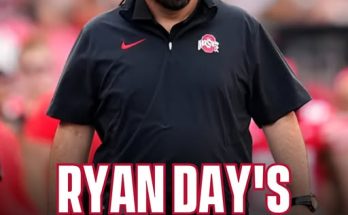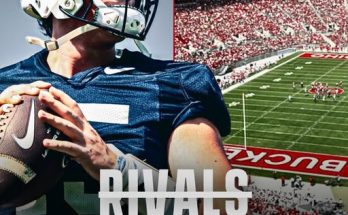In a world where college football is increasingly dominated by portal poaching, NIL deals, and NFL Draft declarations, the story of Alabama’s last homegrown national champion still on the roster reads like a page out of a forgotten playbook. He’s not the loudest voice in the room, and he’s certainly not the flashiest name in the headlines. But if you ask around Tuscaloosa — not just within the team facility but in the surrounding community — there’s a good chance you’ll hear a nickname before a stat sheet: Paw Paw.
That’s what they call him now. And he wears it like a badge of honor.
At 24 years old, Alabama’s sixth-year senior defensive lineman Jamarcus “Paw Paw” Henderson is a relic of an earlier era in Crimson Tide lore — the final player left from the 2020 national championship squad who hails from within Alabama state lines. Back when he committed, the word “dynasty” was spoken with certainty. Nick Saban was untouchable, the playoff was four teams, and Henderson was a raw but relentless four-star out of Prattville, Alabama — a product of work boots, Friday night lights, and SEC dreams.
He redshirted his freshman year behind a loaded front seven that included Christian Barmore and Phidarian Mathis. In those early days, he didn’t play much, but he soaked it all in — the structure, the expectations, the way winning wasn’t a hope but a habit. He was there on the sideline at Hard Rock Stadium in January 2021 when Alabama capped off a perfect 13-0 season by crushing Ohio State. He didn’t get a snap that night, but he still remembers the sound of the confetti hitting the turf like it was yesterday.
“I remember just thinking, this is what it’s all about,” Henderson says, looking back. “That’s what I came here for. To be part of something bigger than myself. To wear that ‘A’ and know it stands for championships.”
Since then, everything has changed — except him.
He’s had every reason to leave. Injuries. A coaching change. A younger, faster rotation of 5-stars nipping at his heels. The transfer portal cracked open the gates for instant gratification, and friends across the country were cashing in. NIL became a game of numbers. Henderson watched teammates bounce from program to program, chasing bigger checks and bigger brands. But he stayed. Six seasons, three position coaches, and one national title ring later, he’s still grinding in the trenches, still chasing another shot at glory.
Why?
“I owe it to this place,” he says simply. “I owe it to myself. And I owe it to everybody back home who believed in me when I was just a skinny kid from Prattville.”
That’s the thing about Henderson. He’s not just playing for Alabama. He’s playing for Alabama. The state. The culture. The people who speak in slow drawls and keep their Saturdays sacred. He’s become something of a bridge — between eras, between teams, between communities. The locker room calls him “Paw Paw” half-jokingly because of his age and wisdom, but there’s more reverence than ridicule in it.
“He’s like the soul of our defense,” one younger teammate says. “You don’t really know what that means until you’re around him for a while. He just carries that standard with him.”
Henderson’s career numbers won’t wow anybody. He’s never been All-SEC. He doesn’t have a million followers or a trademarked celebration. But in Tuscaloosa, he’s become essential in ways you can’t always measure with a stat line. He’s the one organizing film sessions after hours. He’s the one staying behind after practice to help walk-ons with technique. He’s the one defensive coordinator Kane Wommack leans on when the energy in the room needs to be recalibrated.
“He sets the tone,” Wommack says. “He’s not trying to be flashy. He’s trying to win.”
It would’ve been easy for Henderson to take a backseat in the new era. Alabama underwent a seismic transition this offseason with Kalen DeBoer taking over the reins after Saban’s retirement. Suddenly, the program that had been defined by one voice was finding its footing with another. Players entered the portal. Some left. Some returned. Through it all, Henderson stayed — one of the few constants in a time of change.
He wasn’t just another name returning for a “COVID year.” He was the anchor.
“Kalen came in and asked us what this place meant to us,” Henderson recalls. “I told him it’s not just about banners and rings. It’s about identity. You put on this jersey, and you represent every kid who ever dreamed about playing here. You don’t quit on that.”
Now in his sixth year, Henderson is finally expected to start full-time — a payoff for patience, persistence, and an unrelenting motor. Younger linemen marvel at how he treats every rep in spring camp like it’s fourth-and-goal in Atlanta. There’s a hunger to his game that belies his senior status, a chip on his shoulder he never seemed to lose.
He knows his NFL stock is murky at best. He’s undersized by pro standards and overaged by scouting departments. But ask him what he wants out of this final year, and he doesn’t mention Sundays. He talks about Saturdays.
“I want to leave this place better than I found it,” he says. “That’s it.”
There’s a quiet pride in how he represents the last vestige of an era that’s almost gone — when Alabama’s roster was still dotted with homegrown kids from Dothan, Mobile, and Montgomery. In recent years, the recruiting reach has expanded. California quarterbacks. Georgia cornerbacks. Florida speedsters. The Crimson Tide are now a national brand with national talent. But Henderson remains a symbol of the old guard — a reminder that this dynasty was built on the backs of Alabama boys with Alabama dreams.
Local fans adore him for it. After practice, he’ll often be the last player signing autographs. Not because he’s the most popular, but because he’s the most familiar. He looks like them. He sounds like them. And in many ways, he’s playing for them.
“It means a lot to folks around here,” says his high school coach, Doug Brown. “Jamarcus is one of ours. And he’s still out there, still fighting, still believing. That’s special.”
It is special — especially in an era where staying put is seen as settling and loyalty is often a luxury. Henderson knows this may be his last ride. He’s feeling it in his knees, his back, his lungs. But he’s also feeling it in his heart — the pull to finish strong, to lead one more charge, to leave his fingerprints on the program that shaped him.
He doesn’t talk much about the legacy he’ll leave. That’s not his style. But if you watch how the younger guys look at him, how the coaches speak about him, how the fans chant for him — you realize it’s already etched in stone.
He’s the last homegrown national champion left in Tuscaloosa. A quiet guardian of tradition. A mentor. A leader. A survivor of the portal age.
He’s Paw Paw. And this fall, one last time, he’s coming for everything.



